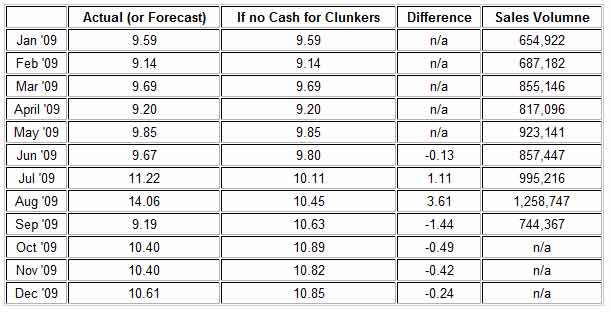We’ve got mail – Cash for clunkers cost $24,000 per car
During the radio show Thursday, Jim was discussing the Cash for Clunkers program and the Edmunds.com press release where they calculated 125,000 car sales were added to what would have already been sold between July and December this year. The government pushed many purchase into the 29 day period, and Edmunds figured 565,000 of those cars would have been purchased anyway.
Radio Vice Online reader Paul chimes in…
Jim You use Junk Science report. The Number of Cars that took part in program was almost 690K. If you factor in these numbers, the cost is under $5K per umit [sic]. Tell the truth how Edmunds took only 120K vehicles for thier [sic] number crunching fiasco of Obama Bashing!
Well Paul you see, totally misses the point. There was no number crunching fiasco, since Edmunds clearly wrote in the second paragraph of their release that …
Nearly 690,000 vehicles were sold during the Cash for Clunkers program, officially known as CARS, but Edmunds.com analysts calculated that only 125,000 of the sales were incremental. The rest of the sales would have happened anyway, regardless of the existence of the program.
Paul thinks the program costs less than $5,000 per car, which assumes all of 690,000 units would not have been sold during the time period the government program affected the market place. Paul simply calculated $3 billion divided by 690,000 to come up with about $4,300 per car. Paul also is stuck on the “bashing Obama” theme. We’re simply pointing out facts about the program that are not in dispute.
Edmunds put some thought into calculating how many people waited to buy and how many bought early. They determined additional sales of 125,000 units, meaning 565,000 of those new cars would have been purchased over time anyway.
If Paul and others want to dispute the analysis from Edmunds, go ahead, do the research and come up with your own figure. But to claim that all 690,000 of those light vehicles were sold thanks to the federal program implies you’ve got zero understanding of economics let alone basic math.
To conduct the analysis, the Edmunds.com team of PhDs and statisticians examined the sales trend for luxury vehicles and others not included in Cash for Clunkers, and applied the historic relationship of those vehicles to total SAAR to make informed estimates. These estimates were independently verified through careful examination of sales patterns reflected by transaction data. Once the numbers were determined, Edmunds.com’s analysts divided three billion dollars by 125,000 vehicles to arrive at the average $24,000 per vehicle.
Granted, this is not a simply calculation, and honestly the Edmunds’ chart below does not help the average reader understand how they came up with the 125,00 unit figure.
Edmunds routinely forecasts car sales in advance, and for 2009, they charted out actual sales versus estimated sales without the program. Consumers knew the CARS program was coming in June and July, which actually delayed purchases of vehicles during that period of time right up to July 27 when sales skyrocketed. Also, consumers made the decisions to buy earlier then planned, during the 29 day program, instead of making the purchase after the program ended.
Although the included chart provides details and estimates through Dec. 2009, I did speak with a spokesperson at Edmunds and their analysis did consider some sales were moved up into August from those who would have purchased in 2010. So the ultimate question is how many more vehicles were sold because the program’s existence?
Although the chart below does not help me understand the 125,000 figure, that’s what Edmunds came up with.
Hot Air has more, but I’d also suggest reading a post over at American Thinker by Randy Fardal called Hit and Run covering three different ways of looking at the data. Fardal’s analysis, backed by data from Motor Intelligence, shows the cost between $9,000 and $56,000 per incremental sale depending on how you look at the data. With Edmunds number at $24,000 per incremental sale, it’s probably a good estimate and right in the middle.
It’s certainly not $4,500 per incremental sale, that’s for certain.
More over at Hot Air today (Friday).
9 Comments
The website's content and articles were migrated to a new framework in October 2023. You may see [shortcodes in brackets] that do not make any sense. Please ignore that stuff. We may fix it at some point, but we do not have the time now.
You'll also note comments migrated over may have misplaced question marks and missing spaces. All comments were migrated, but trackbacks may not show.
The site is not broken.


Are you serious? The headline Clearly reads "Taxpayers Paid $24,000 per Vehicle Sold" Which is 100% NOT true.
If you want to understand what the cost per car is then you divide the total cost by the number of vehicles. This is a very simple calculation. $3mm divided by 690k. You come up with about $4,300 per car.
If you want to calculate what the program costs to stimulate buying of cars that otherwise would not have been bought, then you take that number 125,000 and you multiply it by the cost per car that we have already calculated, you do not divide it from the $3 billion. Dividing it by $3 billion does not make any sense whatsoever. The number that you get $24,000 is NOT in any way a cost per car of anything as it relates to this matter. The caller is correct, this report is totally illogical and total junk.
When you fabricate things like this it calls into question all of the other things that you post here. Most people will never try to figure it out and just take your word for it, but anyone that really thinks about it realizes that the number is total BS.
-Erik
Ha, I read the hot air post and it is exactly that, hot air. This is Al Gore logic. You would not divide the subsidy out in that manner, because if the program were only for people that otherwise were not going to buy a car then it would NOT have cost as much as it did. It would have cost only a fraction of what it actually cost.
@Erik – the data is out there. You tell me. How many more cars – than would have already been purchased between the start of the program and the end of the year – were bought by consumers as a result of the federal government spending $3 billion?
The way I look at it, Edmunds says the increase in sales was 125,000 units and the government spent $3 billion on the program. That's the math. What about the American Thinker piece?
So maybe the headline should read Taxpayers Paid $24,000 per EXTRA Vehicle Sold or something like that?
If the only problem is the Edmunds.com article TITLE I will agree it is misleading; but stipulate the article, and this post, clearly explain.
By the way, insulting me is getting you nowhere.
@Steve, I will accept the 125k car number. But to calculate the cost for selling those cars, you do not divide it by $3 billion. You need to take the overall cost, divide it by the TOTAL number of cars, and then take that number and multiply it by 125k. The $24k number is nothing, it is NOT the cost per car of ANYTHING… The logic is flawed, take the time to think about it.
Are you seriously insulted? I apologize for actually thinking this through and doing the proper math. I will try to think less from now on.
-Erik
OK – how can we make the title of the post – or the analysis – more clear for the readers? I'm willing to update and refine.
The government spent $3 billion (total cost of the program) and in return, the car industry sold 125,000 more cars than it would have without the government incentive.
They claimed the program was a huge success and at the end, the headlines everywhere were similar to <a href="http://www.google.com/search?q=Cash+for+Clunkers+generates+700%2C000+new+car+sales&ie=utf-8&oe=utf-8&aq=t&rls=org.mozilla:en-US:official&client=firefox-a" target="_blank" rel="nofollow">Cash for Clunkers generates 700,000 new car sales. (The link simply provides search results for the phrase.) Those headlines implied those cars would not have been sold without the program, which is incorrect.
Up until the Edmunds press release, many knew many sales had been "shifted" but there was no analysis about the shift to determine how many cars would have been sold without the incentive. Edmunds' research (as well as the analysis over at American Thinker) provides us with some numbers.
One could mention that all of the cars traded in would have eventually been replaced over time, but how can we measure the return on investment in this case? Was the program really a success? (Note I don't think it should have been implemented in the first place.) We spent $3 billion – what did we get?
The point is being missed. The federal government does not have the right to take my hard earned money, put my small business in jeopardy (we are teetering on bankruptcy), put my wife out of work, thus harming me and my family so that someone out there can buy a new car! So, my personal income tax has just paid for 4-5 new cars. What does it get me? NOTHING! The news report today says that consumer spending is plummeting due in part to the end of "CARS" program. Therefore, it IS an artificial boost to the economy that was short-lived and ineffective. We are officially Doomed!
amen brother. I am tired of paying taxes so that people can live better than me. I drive an 11 year old car and no one going to pay for me to get a new one. If you want to stimulate, give me my tax money and I'll buy myself a car. But as John Kerry says, I can't be trusted with my own money that I earned, I can not be relied upon to use it for a car.
Your headline should read "Edmunds data has serious logic flaw" The Edmonds headline should be "How to calculate an absolutely meaningless number and use that number as political rhetoric.
I agree 100% that claims of an additional 700K cars sold are total bull as well. The American Thinker analysis is a much better analysis, that falls off the tracks when they cite the $24k number.
If the point is that people drained out the current vehicle inventory and reduced demand coming up to and going away from the program then there are probably plenty of articles to make that point. We spent $3 billion and what did we get? Auto inventory reduction, supposedly reduction in carbon emissions. Things that are not government responsibility in the first place, we have no business giving people money to buy a new car.
How about this alternate headline? Government blows $3 billion to increase car sales one-tenth of a percent for the year … and they never should have done it in the first place since they stole money from me to give it to someone else